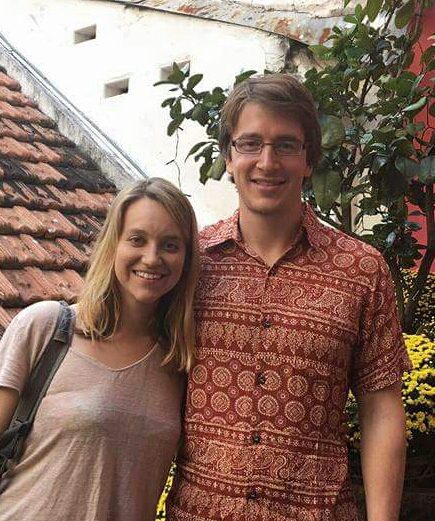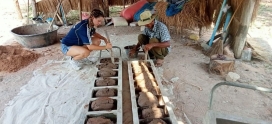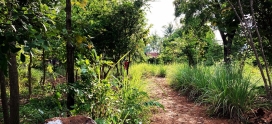Samrong diary 1
Hello, my name is Katie Erwin and my partner Kyle Brolis and I have just begun our short mission with Green Shoots and their local partner CIDO in Samrong, Cambodia for one month. We’re here to learn about and evaluate the Agriculture Skills in Public Schools (ASPUS) Program as well as to provide training to CIDO on topics related to best management practices for organic agriculture.
CIDO (Community-based Integrated Development Organization) has been supporting farmers in the area for over a decade. In Samrong, most vegetables at the market today are actually imported from Thailand and Vietnam, and most are grown with chemicals. We were advised to avoid eating raw vegetables. Almost all farmers here focus on cassava (potato-like tuber) to sell abroad. After harvest, it gets chopped into pieces which are lain out to dry along the road. The cassava is then sold to a Thai company which processes it into alcohol.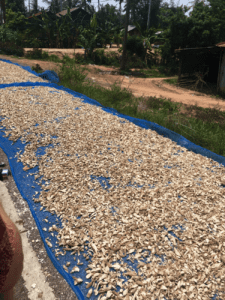
Unlike in the U.S., where organic farmers have to be creative and try and find a “niche”, farmers in Cambodia are all growing the same thing and selling to large buyers because that’s how they can get the best price for the crop. There is not really a demand for local vegetables as people are largely content paying for the cheaper (non-organic) imports. We can understand that many farmers may be afraid to try anything new because they are barely making ends meet as it is. Food security and nutrition are real concerns here- making the work of Green Shoots and CIDO to educate the next generation about growing food all the more important.
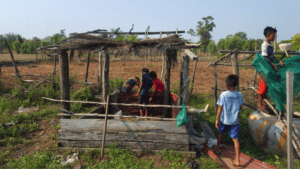
We arrived right on the cusp of rainy season and the anticipation is high among all species. The extreme heat puts a serious stress on the crops, so CIDO is trying to address strategies for improving resilience due to climate change. On our first day in Samrong, the CIDO staff took us to visit two schools nearby. At the first, we saw compost (both liquid and dry) being made with the help of giggling students who gathered materials such as manure and green leaves from a native species rich in nutrients.
The garden space had just been plowed with a hand tractor in preparation for planting.( Lift wooden lever to pump water out) One of the most impressive components of the site was the hand-powered water pump which fills the container that gravity feeds water into the drip irrigation system.
I think it is really remarkable that Green Shoots and CIDO were able to install ponds at almost all schools, which not only irrigates the garden but provides water to many neighboring families.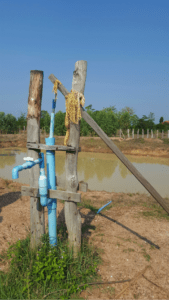
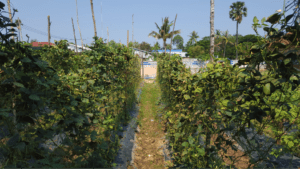
At Samrong Primary School they are growing eggplant, tomatoes, long beans and wax gourd. The gourd plants are led up an over-hanging trellis that creates some shade for the basil plants underneath. A few jovial lemongrass plants create a border that deters pests 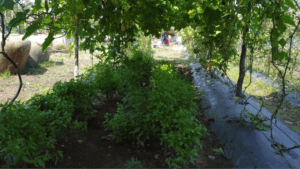 by the smell. We are excited to see these creative approaches!
by the smell. We are excited to see these creative approaches!
Today, we had the unique opportunity to participate in the quarterly Project Steering Committee meeting where we sat around the table with eight school and community leaders. They shared some of the challenges the School Garden Facilitators have been facing and discussed possible solutions.
Later, we visited the Roneamtham Primary School which is growing (really) long beans, eggplant, leeks and morning glory.
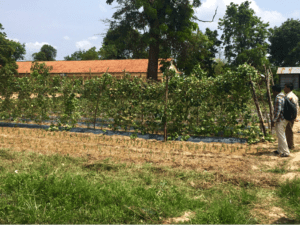
Yellowing leaves expressing stress
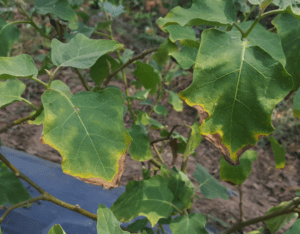
They have a wealth of fertile compost there that’s got a lot of biological activity going on.
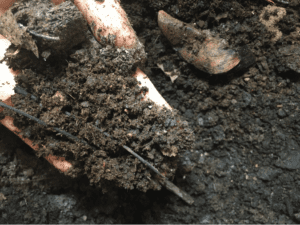
Needless to say, we are very happy to be here and to be a part of such an important project here in Cambodia. We look forward to visiting more schools this week and continuing our research and evaluations.

